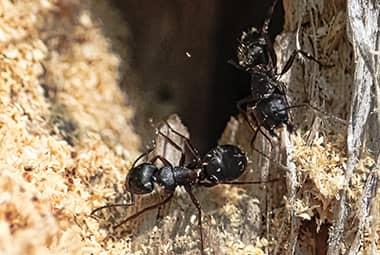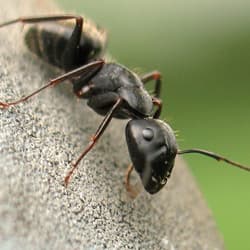Are you seeing small ants in and around your home? Or small piles of sawdust? You could potentially be dealing with carpenter ants! Those few ants you’re seeing could end up increasing in number fairly quickly. If you aren’t familiar with carpenter ants, you should know that these pests can do some serious structural damage as they make their nests inside the wood—a.k.a your home. These ants are bad news!
Carpenter ant infestations usually start off with a few ants scoping out your property. These are known as “scout” ants. It will be up to them to determine whether your home is fit for the colony to move in. What makes your home attractive to carpenter ants? They need sources of food and water. Carpenter ants also are attracted to damaged or damp wood and will choose these areas as their first location for making a nest. However, they will then move on to dry wood as their colony grows. And they aren’t actually eating the wood, only making nests inside it. So, as for their food, they may rummage through your pantries and food-storage areas to find their meals. Any crumbs or spills will attract them as well.
The sooner you find these ants the better! A carpenter ant infestation that has gone on too long can result in buildings becoming unsafe to live in. They will bite away chunk by chunk with their powerful jaws day after day. With the size of their colonies, it doesn’t take long for the damage to build up. It’s important to know the signs of a carpenter ant infestation.
Signs Carpenter Ants Leave Behind:
- Seeing the ants inside your home is a sure sign of an infestation. These ants may be black or red, and some could even have wings. Discarded wings could be left behind.
- Any damaged or decaying wood is subject to carpenter ants, so watch out for this. It’s important to replace the wood and fix the damage as soon as possible.
- Sawdust or tunneling is another sign of carpenter ants. As the ants tunnel through to make their nest, they will leave behind small piles of sawdust and the wood may appear brittle and break apart.
- It’s also important to know where to look for carpenter ants. As mentioned above, any damp wood is susceptible to an infestation and their hotspots for making nests include windows, chimneys, bathrooms, and door frames. Any hollow spaces could potentially be at risk.
- Any damage to your home should be inspected. Carpenter ants are known to cause sagging ceilings and floors, as well as unstable walls. If you’re noticing any of these, it’s important to seek a professional.
If you’re seeing any signs of a carpenter ant infestation, it’s advised to call a professional pest control company. Russell’s Pest Control has been serving Knoxville and eastern Tennessee for over 45 years. If you live within these areas, our team will partner with you to inspect and eliminate pests from your home. Better yet, they can help prevent pests from ever entering! We have different program options that will keep your home pest free and safe from the damage carpenter ants can cause. Contact Russell’s Pest Control today to get rid of your pest infestations!

